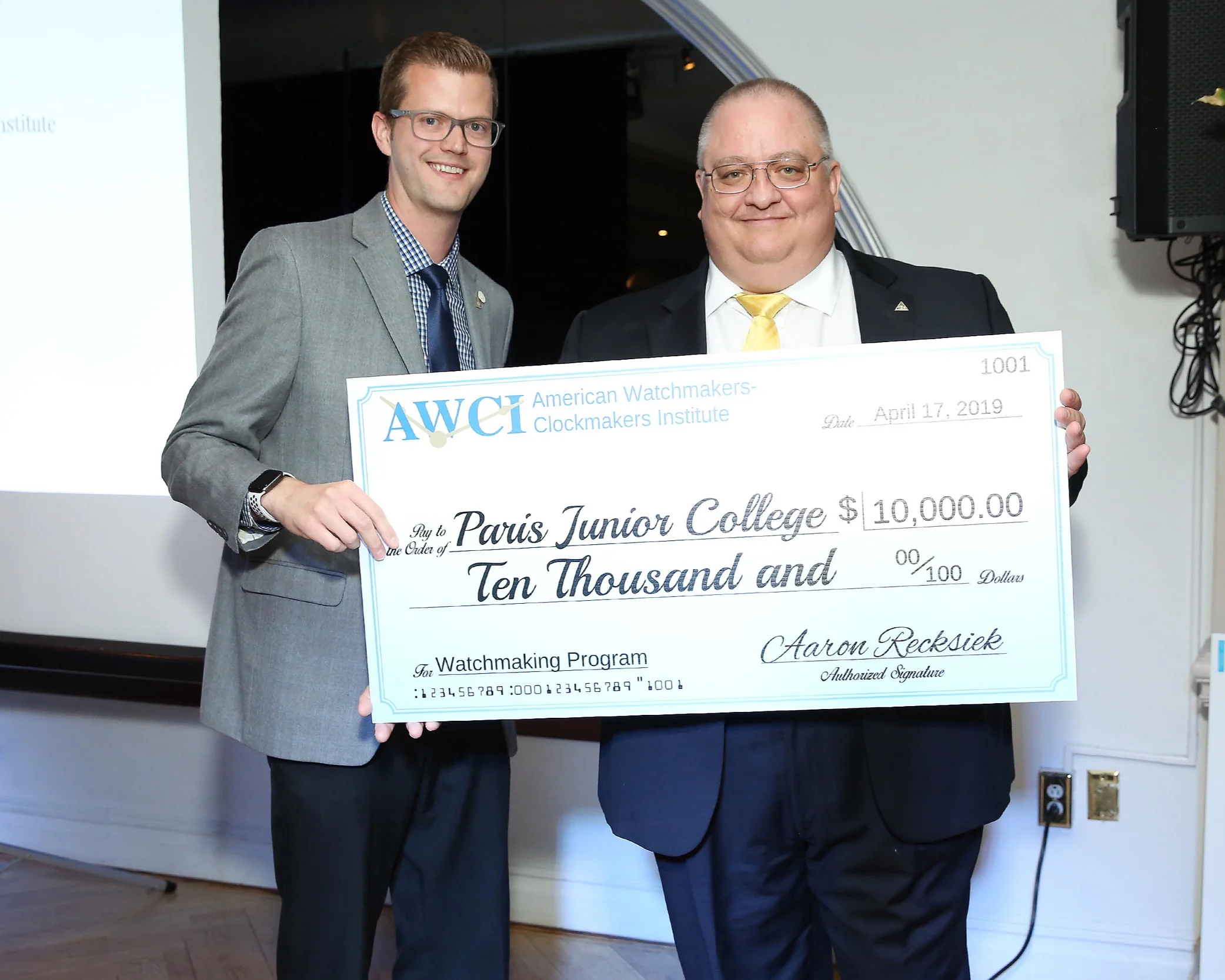
The Horologist’s Loupe
The Horological Society of New York's newsletter (and today blog!) began publishing in 1936, and is one of the oldest continuously running horological publications in the world.
Upcoming Lecture: Simon Willard Eight-Day Clocks: In Search of the Finely-Divided Trade, 1785-1825
Join HSNY on Tuesday, September 10, 2019 for a lecture on Simon Willard Eight-Day Clocks: In Search of the Finely-Divided Trade, 1785-1825, by Robert C. Cheney, Executive Director of the Willard House and Clock Museum.
As the most complicated trade in 18th century America, clock making relied heavily on a finely divided shop structure to produce domestic timekeepers. Cabinetmakers, carvers, gilders, dial makers, painters and at least seventeen different metal-working trades all joined forces to capture the fervor of nouveau riche Americans to mimic fine English interiors with locally produced furniture, silver, portraiture and clocks to fill elegant new homes. At the September 10, 2019, meeting of the Horological Society of New York, Robert C. Cheney will discuss the fascinating history of Simon Willard eight-day clocks. Previous scholarship by Cheney has documented a little known, but extensive trade in Liverpool and Birmingham goods to supply Willard and others with most of the materials and components needed to fill the needs of an emerging American market. Cheney's HSNY lecture will widen the importance of Liverpool and Birmingham for American clock production and discuss how Willard began to recreate English methodology in Boston by 1800.
In The News: HSNY Trustee William Massena Discusses the Role Clocks Played During Shakespearean Era
In today’s age, we have time management down to a science when it comes to putting on a play. They start on time, intermissions are calculated to the last minute, and acts are rehearsed to fit within time frames. But how was time measured in Shakespeare’s day, and what importance does time play within the works of the man widely regarded as the greatest writer in the English language? HSNY Trustee William Massena sheds light on another William - Shakespeare that is - in this podcast by Cassidy Cash.
Time Goes Back In Time: Europa Star Archives Over 90 Years of Horological History
If you've ever wanted to learn about all aspects of horology and its rich history, look no further than Europa Star and the exciting new project they've embarked on. The global watch magazine, which has been delighting industry professionals and enthusiasts alike since 1927, is currently on a mission to archive over 300,000 pages of fully searchable horological material. Ranging from brand profiles to the hottest advertisements of the era, Europa Star is bringing over 90 years of history to the palm of our hand, offering a comprehensive insight into the past with hopes of learning from its failures and successes.
Click here for more information and to learn how to access the archives!
Follow @watch_heritage for Europa Star's daily dose of vintage watches!
Welcoming New HSNY Members, June 2019
HSNY would like to welcome the following new members. It is with your help that we are able to continue flourishing as America's oldest watchmaking guild, and your commitment to HSNY helps us advance the art and science of horology every day.
Adam Cook, FL
Alexander Hennessy, NY
Bill Banks, Canada
Bo Meng, CA
Bradford Sheridan, TX
Brian Quinn, NY
Corey Sherman, NY
David Olson, NV
Greg Kling, CA
James Kong, NY
Joel Nelson, FL
John O'Hearn, MD
Joseph Kraeutler, NY
Michael Margolis, CT
Nathalie Wheldon, CA
Nicholas Brawn, Hong Kong
Peter C Jachym, NY
Phillip Nolan, Australia
Sandesh Tuladhar, NY
Scott Visin, TX
Serge Maillard, Switzerland
Thomas John Wilson, NY
Victor DiMartino, NJ
Zachary Turnbull, NY
Zaeem Baig, PA
HSNY Summer 2019 Survey (NOW LIVE)
Our summer 2019 survey is now live! Please take a moment to answer a few questions in order to help us with future planning. Have additional comments or ideas? Drop us a line here.
The Horological Society of New York to Host Classes in London with the British Horological Institute
(NEW YORK) Two of the world’s oldest horological organizations are joining forces to teach horology classes in London on August 31 and September 1, 2019.
With a combined existence of over 300 years, the Horological Society of New York (HSNY) (founded in 1866) and the British Horological Institute (BHI) (founded in 1858) are making history with their first partnership to advance the art and science of horology.
The BHI, who recently celebrated its 161st anniversary on June 15, is welcoming America’s oldest watchmaking guild across the pond to teach HSNY’s coveted Traveling Education courses, which cover lessons in movement mechanics, gear training, and winding and setting. Classes will be hosted at The Clockworks, a unique studio in London centered around electric clocks that combines a museum, workshop, library and meeting space under one roof.
HSNY’s first visit to Europe will be presented by Vincent Robert, Director of Traveling Education, who along with a BHI instructor, will guide an intimate group of students in finding out what makes a mechanical movement tick. Each four-hour course will include the disassembly and reassembly of an ETA 6497 movement for the duration of the course, along with explanations of proper usage of watchmaking tools and of modern horological terminology and theories. No prior experience is required for horology enthusiasts to enroll.
HSNY’s Traveling Education courses in London will be offered (in BST) on Saturday, August 31 (9:00AM – 1:00PM & 2:30PM – 6:30PM) and Sunday, September 1 (9:00AM – 1:00PM & 2:30PM – 6:30PM).
Admission is $500 USD and ticket sales are directly reinvested into HSNY’s ongoing educational mission. The Clockworks is located at 6 Nettlefold Place, West Norwood, London SE27 0JW, UK.
Meeting Recap: Spring Drive: A True Expression of Nature and Time
Joseph Kirk, Brand Curator and National Trainer for Grand Seiko Corporation of America
Monday, June 3, 2019
Video recordings of lectures are available to members immediately (using your membership password), and the general public with a 2 month delay.
“Japan’s history is very old, so time flows slowly for us. I think that’s very important for Japanese people. Looking at the movement of the second hand, it’s like being able to feel the natural slow flow of time, and I think that makes it a very Japanese watch.” - Mr. Yoshifusa Nakazawa
That’s how Joseph Kirk, Brand Curator and National Trainer for Grand Seiko Corporation of America, started the June 3, 2019 lecture of the Horological Society of New York. Kirk believes the quote encapsulates the vision of the Spring Drive as it relates to Japan. In the mid-7th Century, Japanese timekeeping was influenced by nature such as the Rokuku (water clock) and the Wadokei (temporal time clock that measured time by season that was primarily weight driven). Under the leadership of Kintaro Hattori who founded Seikosha (aka Seiko), the following timekeepers reflected the ‘firsts’ of the brand, starting with the mainspring powered clock (1892), the pocket watch (1895), the lever escapement (1899) and the wristwatch (1913).
Before explaining the concept of the Spring Drive, Kirk provided an overview of the mainspring and barrel, gear train, escapement and regulator mechanism to provide contrast to Seiko’s unique movement. In regards to quartz mechanisms, the inverse piezoelectric effect showcased the high accuracy due to its oscillation rate.
Advancements in technology provided Seiko the means to increase the power reserve in the Spring Drive prototypes: First it was 4-hours, then 10-hours due to integrated circuit technology, finally to 48-hours due to new integrated circuit technology.
So, the question regarding the Spring Drive: How does it work? One of the unique aspects of the Spring Drive is the Tri-Synchro Regulator which is composed of the glide wheel, permanent magnet, coils and coil block. The energy usage of the mechanism includes mechanical (generates current), electrical (powers the integrated circuit) and electromagnetic (applies the brakes to the glide wheel). Another aspect is the Silicon on Insulator Integrated Circuit (SOI IC) to prevent power loss. To maintain energy efficiency, the coil is wound 25,000 times around the block, the pinion is polished to reduce friction and the mainspring (which is proprietary) provides high torque. It took from 2006 to 2019 to improve on the Spring Drive movement by producing the Sonnerie, Chronograph GMT, Minute Repeater.
The lecture concluded by Kirk introducing special guests Mr. Akio Naito, Chairman and CEO of Grand Seiko Corporation of America, and Mr. Kazunori Hoshino, Product Planner and Designer of Seiko Epson Corporation. Both men gave their perspectives on ‘the beauty of utility and functionality’ of the Grand Seiko brand in terms of its design and craftsmanship.
HSNY thanks Joseph Kirk for his fascinating lecture, and gratitude towards Mr. Akio Naito and Mr. Kazunori Hoshino for their attendance!

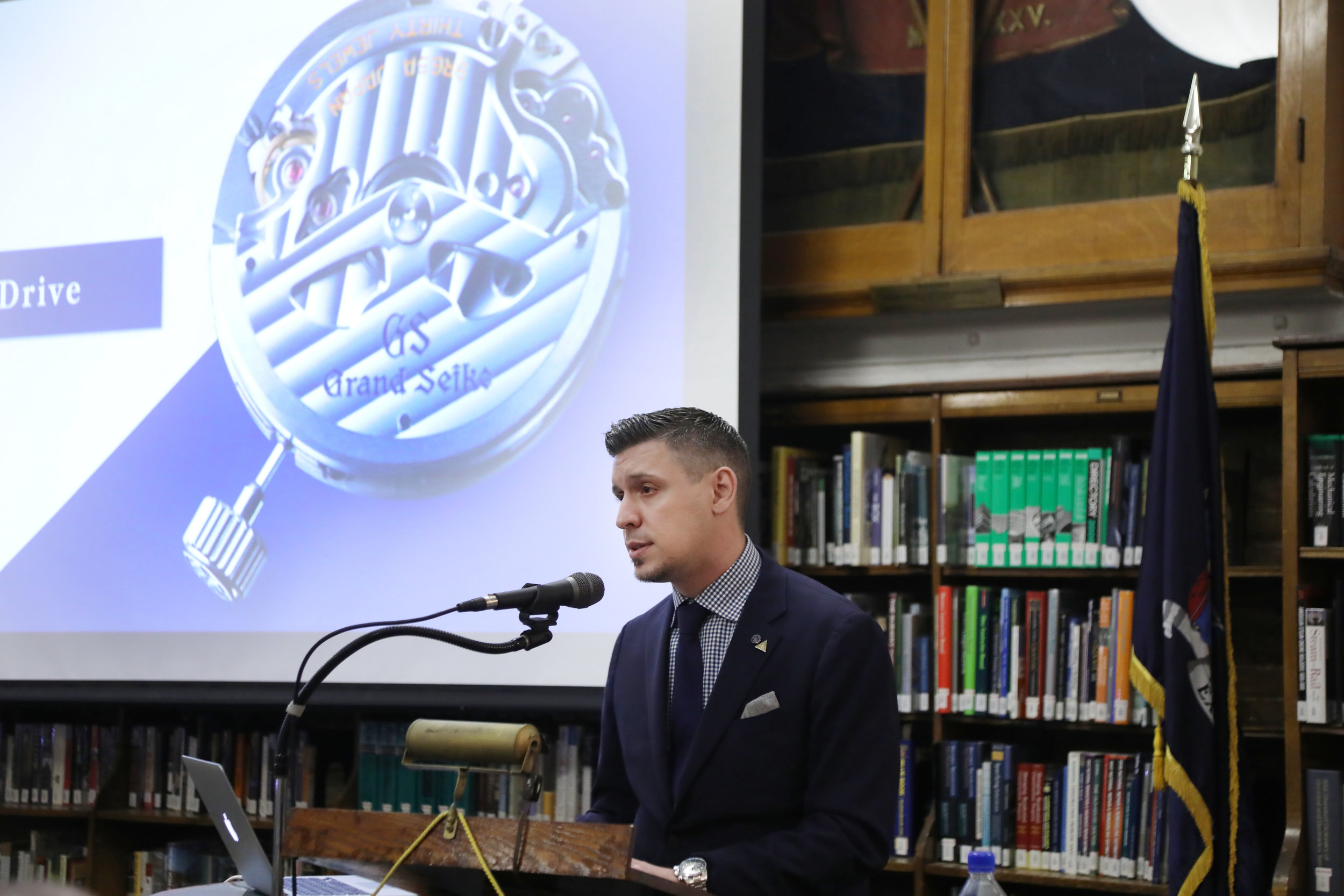
















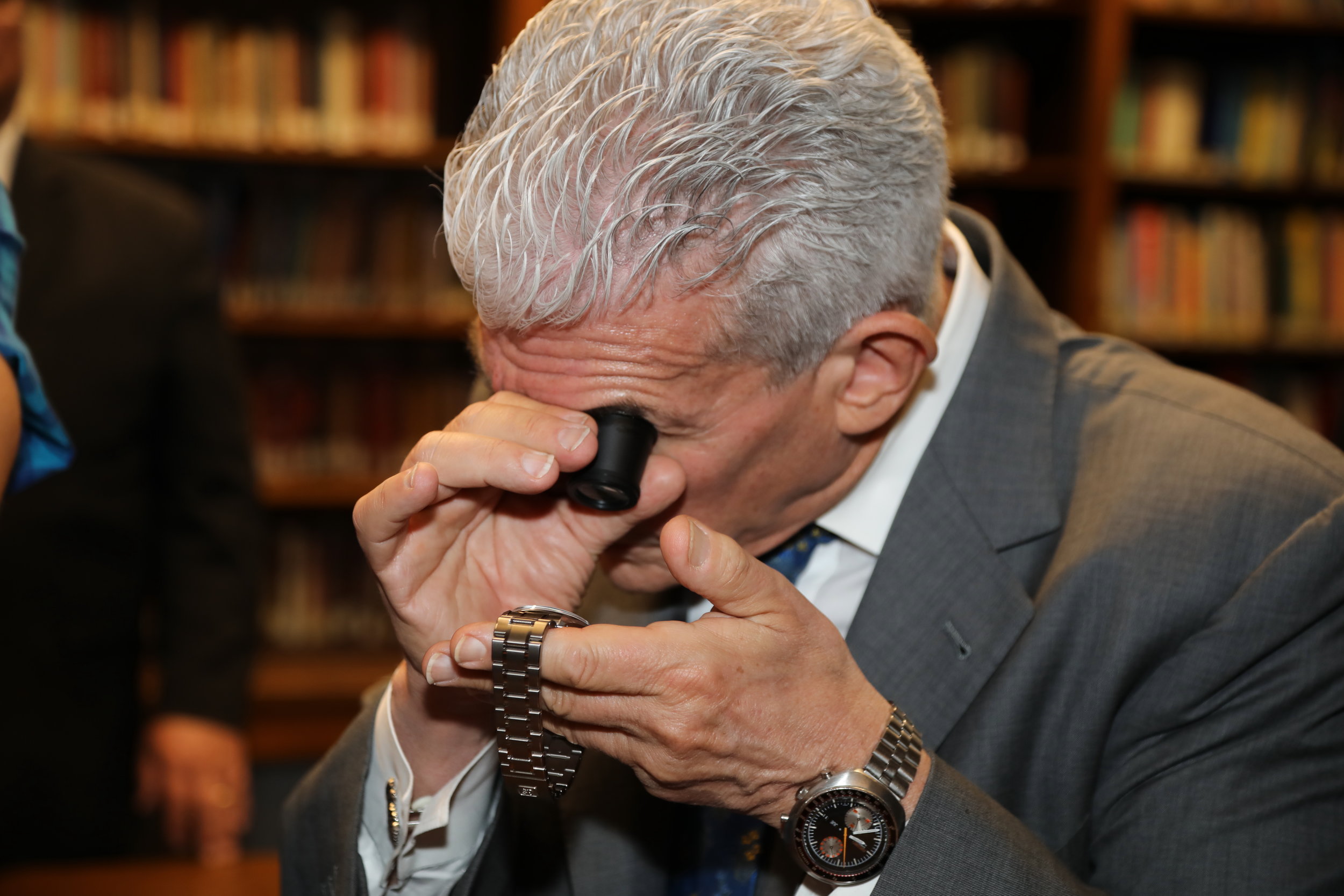



Photography by Ellen Wallop
Submitted by Melody Benloss, HSNY Librarian & Recording Secretary
NAWCC To Host 2019 Ward Francillon Time Symposium in Germany
Time Made in Germany — 700 Years of German Horology
September 12 – 15, 2019
For the 2019 Ward Francillon Time Symposium, the National Association of Watch and Clock Collectors (NAWCC) is joining its German counterpart, the Deutsche Gesellschaft für Chronometrie, in organizing a groundbreaking international conference on the history of German horology. Many of the crucial developments in clock and watchmaking occurred in Germany. Never before have these timekeepers and innovations been examined and described as comprehensively.
For English Speakers
Although the presentations will be delivered in German, English speakers will be provided with written and/or spoken translations. In addition, the texts of the lectures will have been translated in advance and published in hardcover volumes in both languages.
Registration deadline is August 30.
For more information, visit www.timemadeingermany.com.
Madison Avenue Watch Week Set for June 10 - 15, 2019
Madison Avenue Watch Week has become an annual New York City tradition when premier watch retailers offer a “first look” at the timepieces launched at the 29th Salon International de la Haute Horlogerie and the 2019 Baselworld Watch and Jewelry Show. The 9th Annual Madison Avenue Watch Week is scheduled from Monday, June 10 - Saturday, June 15.
Open to the public, this year’s impressive roster of the participating watch brands includes A. Lange & Söhne, Apple, David Yurman, De Beers Jewellers, F.P. Journe, Hublot Boutique, Jaeger-LeCoultre, Montblanc, Panerai, Smythson and Vacheron Constantin. The retailers will offer artisan demonstrations; master classes with watchmakers; presentations regarding trends in design, manufacturing and mechanism technology; exhibitions of new collections, in-store receptions, incentives and giveaways, and exclusive VIP sales appointments.
Visit http://www.madisonavenuewatchweek.com for full details!
Welcoming New HSNY Members, May 2019
HSNY would like to welcome the following new members. It is with your help that we are able to continue flourishing as America's oldest watchmaking guild, and your commitment to HSNY helps us advance the art and science of horology every day.
You’re never too old (or too young!) to become a member. (Photo credit Monica Schipper)
Christopher Lavagnino, NY
Derek Mon, NY
Dzianis Karchahin, Canada
Gary Barrett, IN
Jeffrey Lane, NC
Joseph Soufer, CT
Joshua Dolin, NY
Patrick Hylton, CA
Patrick Ryan, NJ
Salvatore A Vitale, NY
William Sanders, CT
Upcoming Lecture: Spring Drive: A True Expression of Nature and Time (Special Guests)
Join HSNY on Monday, June 3, 2019 for a lecture on Spring Drive: A True Expression of Nature and Time, by Joseph Kirk, National Training Manager for Grand Seiko Corporation of America.
Spring Drive is a movement technology developed in-house by Seiko Epson, formerly known as Suwa Seikosha, in the Nagano Prefecture of Japan. Development of the technology started in 1977, and debuted in 1999 in limited quantity in Japan. In 2004, Spring Drive became available globally in Seiko, Credor and Grand Seiko watches. At the June 3, 2019, meeting of the Horological Society of New York, Joseph Kirk will discuss the many hurdles that Seiko overcame with Spring Drive before it could be introduced to the world.
Spring Drive movements combine the best aspects of mechanical watchmaking, such as the power source of a wound mainspring, along with a unique regulating system as its escapement. The precision of a quartz oscillator and an electromagnetic braking system provide extremely high accuracy and unidirectional motion, with no collision. This is solely achieved with the mechanical energy derived from the mainspring, eliminating any need for a battery. The end result is a spring driven watch that achieves quartz like accuracy. This unique movement type expresses time unlike others, with a completely continuous gliding seconds hand with no sweep or tick.
SPECIAL GUESTS
Akio Naito, Chairman and CEO of Grand Seiko Corporation of America, will be in attendance. In addition to his work at Grand Seiko Corporation of America, Naito oversees the rest of the Americas and European market for both the Grand Seiko and Seiko businesses. Naito also serves concurrently as Senior Executive Vice President for Seiko Watch Corporation, Chairman of Seiko UK Ltd., as well as a member of the Board of Directors for Seiko’s subsidiaries in France and the Netherlands. Naito brings over 35 years of dedication to the well-known international watchmaking enterprise, having held leadership roles also in Australia and Japan.
Kazunori Hoshino will be in attendance from the Seiko Epson manufacturer, located in Shiojiri, Nagano Prefecture, Japan. Hoshino began his career with Seiko Epson in 1996 after studying industrial design in engineering at Chiba University. His most notable work includes movement design aesthetics for the renowned Micro Artist Studio movements such as the Credor Eichi II, Grand Seiko 8 Day 9R01, and new Grand Seiko 9R02 caliber.
Images courtesy of Grand Seiko
Meeting Recap: The Ups and Downs of the Greenwich Time Ball - An Overview of Its History, Mechanics and Upkeep
Anna Rolls, Curator of the Clockmakers Museum, London
Monday, May 6, 2019
Video recordings of lectures are available to members immediately (using your membership password), and the general public with a 2 month delay.
On the May 6, 2019 lecture series of the Horological Society of New York, attendees found out that the ball drop on New Year’s Eve did not actually originate in Times Square, New York, as a festive way to bring the New Year. The true purpose of a ball drop has to do with the Time Ball located in Greenwich, England. Guest lecturer Anna Rolls, Curator of the Clockmakers’ Museum in London gave HSNY attendees the history, mechanics and the evolution of the Greenwich Time Ball.
Installed in 1833, it was the first public time signal that was designed to drop at 1:00 pm every day from atop the Greenwich Observatory. The purpose of the Time Ball was created for a practical maritime reason by Robert Morcambe: Sailors need to know the time in order to set their marine chronometers before leaving on a voyage.
The entire Time Ball mechanism which is housed in the Museum building spans three floors via a series of winches, chains and latches with a human assistant on the lower level to trigger release the latches via a regulator. However, upgrades to new technology such as the use of the telegraph system in the train and postal industries made the human assistant redundant since the new master clock could now depend on the telegraph signal itself.
Rolls explained how the weather affected the Time Ball throughout its service: Rusting of clips, the ball itself rotting and after the next upgrade of technology to electricity, there were electrical issues such as the short life span of the components especially when they got struck by lightning, strong winds and the fluctuations of temperature and moisture. Incidentally, strong winds made it the primary factor on whether the Time Ball should proceed with its scheduled 1:00 pm drop.
The upkeep of the Time Ball eventually went to the Museum since the Department of Environment’s caretaking standards were woefully lacking and the need for additional equipment on the structure was entangled to the fact that the Museum is a Grade 1 listed building. Because of that citation, there were repeated delays to install an anemometer system on top of the roof.
To conclude the lecture, Rolls gave an account of what she encountered when the Time Ball had a failure in 2016. Assisted by the Cambria Clock Company, it was found that the ball was out of alignment and paint was removed from the mast. However, after a few successful trials, the Time Ball would fail again. The eventual cause was the magnetic brake of the winch. The motor and the brake needed to be stripped and overhauled. Such is the origins and inspiration for one of New York City’s most iconic landmarks!
HSNY thanks Anna Rolls for her fascinating lecture!
























Photography by Atom Moore
Submitted by Melody Benloss, HSNY Librarian & Recording Secretary
HSNY Announces Hong Kong Traveling Education Tour, June 2019
HSNY’s Traveling Education courses will take place in The Upper House’s Sky Lounge, a sophisticated, airy space on the 49th floor with views of green hillsides and eastern Hong Kong. Photo courtesy of The Upper House.
(NEW YORK) The world of horology is one which transcends cultural boundaries. Enthusiasts, collectors and industry professionals alike are united by common interests of the trade which are fueled by horological education.
After a hospitable welcome and wildly successful weekend of Traveling Education in fall 2018, the Horological Society of New York (HSNY), America’s oldest watchmaking guild, announces its return to Asia, docking in Hong Kong on Saturday, June 8 and Sunday, June 9, 2019. HSNY’s first visit to Hong Kong will be hosted by WatchBox, a global destination for luxury pre-owned timepieces, offering an expertly curated inventory of luxury pre-owned watches for sale, personalized client services, educational opportunities and astute editorial content.
An extension of HSNY’s horology courses taught weekly in the heart of Manhattan, the Traveling Education experience offers students an intimate look into the inner workings of a complete mechanical movement. Led by HSNY’s Director of Traveling Education, Vincent Robert, a class of eight students will disassemble and reassemble an ETA 6497 movement and find out what makes a watch tick.
Each four-hour course covers HSNY’s Horology 101 - 103 curriculum, which includes lessons in movement mechanics, gear training, and winding and setting. No prior experience is required as the proper usage of watchmaking tools and insight into the theories and terminology of modern horology are explained.
The grandiose affair was strategically selected to take place in Hong Kong, undoubtedly a cradle for watch culture and avid collectors. Tucked away from the hustle and bustle of Hong Kong, however, lies the venue - The Upper House, a calming contemporary hotel offering a relaxing oasis by way of modest luxury. HSNY’s Traveling Education courses will take place in the property’s Sky Lounge, a sophisticated, airy space on the 49th floor with views of green hillsides and eastern Hong Kong.
On the evening of Saturday, June 8, WatchBox and The Upper House will extend the horological experience to Hong Kong’s watch community with a party. Students, collectors and enthusiasts are invited to continue the conversation, discuss their personal collections and enjoy cocktails. An array of luxury watches from WatchBox will be on hand to view and try on with the assistance of WatchBox watch specialists.
HSNY’s Hong Kong Traveling Education courses will be offered on Saturday, June 8 (9:30AM - 1:30PM & 2:30PM - 6:30PM) and Sunday, June 9 (9:30AM - 1:30PM & 2:30PM - 6:30PM). Admission is $500 USD (3,923 HKD) and includes access to watchmaking tools and a mechanical watch movement for the duration of the class. No previous experience is required. Ticket sales are reinvested directly back into HSNY’s ongoing educational mission. To purchase tickets, please visit HSNY’s Eventbrite page.
The Upper House is located at Pacific Place, 88 Queensway, Hong Kong.
Tucked away from the hustle and bustle of Hong Kong lies the HSNY Traveling Education venue - The Upper House, a calming contemporary hotel offering a relaxing oasis by way of modest luxury. Photo courtesy of The Upper House.
##
About the Horological Society of New York
Founded in 1866, the Horological Society of New York (HSNY) is one of the oldest continuously operating horological associations in the world. Today, HSNY is a 501(c)(3) nonprofit organization dedicated to advancing the art and science of horology through education. Members are a diverse mix of watchmakers, clockmakers, executives, journalists, auctioneers, historians, salespeople and collectors, reflecting the rich nature of horology in New York City; http://hs-ny.org.
Since the 1950s, HSNY has offered classes to the public, taught by professional watchmakers. These award-winning classes further HSNY's mission by making horological education accessible and enjoyable for the public. HSNY launched its Traveling Education program in 2016, where watch aficionados nation-wide can discover what makes a timepiece tick. In July 2018, HSNY offered its first International Traveling Education class in Toronto, Canada followed by a sold-out tour in Singapore; http://hs-ny.org/traveling-education/
About WatchBox
WatchBox is the world’s leading ecommerce platform for the buying, selling, and trading of pre-owned luxury timepieces; fueled by technology, innovation, and unmatched global experience in the high-end watch market. WatchBox offers an unrivaled selection of pre-owned luxury timepieces for sale and its client services for selling and trading timepieces are streamlined and readily accessible both on and offline, with private showrooms and buying offices in Philadelphia, Hong Kong, South Africa, and Switzerland. Trust, pricing transparency, and authentication are central tenets to WatchBox’s platform, with each watch thoroughly evaluated by the company’s in-house master watchmakers. https://www.thewatchbox.com
About The Upper House
The Upper House is a highly individualised small luxury hotel designed by Hong Kong architect Andre Fu. The hotel’s 117 rooms (including 21 suites and 2 penthouses) start at 730sq ft - the largest in Hong Kong. They feature wonderfully spacious bathrooms and dressing areas, and offer either scenic harbour or island views. Calming and contemporary, the rooms are designed to provide a sense of relaxation, warmth and understated luxury. Café Gray Deluxe, a 21st century ‘grand café’ located on level 49, offers unique style of European classics cuisine from celebrated chef Gray Kunz. https://www.upperhouse.com
HSNY Partners with the AWCI for a Joint $20,000 Donation Towards Horological Education
HSNY President Nicholas Manousos (pictured left) and AWCI President Aaron Recksiek (pictured right) present monetary donations to Paris Junior College Watchmaking Instructor Stanley McMahan. Photo credit Monica Schipper.
New York City, May 1, 2019
Two of America’s most prominent horological institutions are combining forces - and funds - to maintain horological institutions alive in the United States. On April 17, 2019, the Horological Society of New York (HSNY) announced a donation match with the American Watchmakers-Clockmakers Institute (AWCI) at HSNY’s annual Gala & Charity Auction.
During the celebratory evening, HSNY President Nicholas Manousos updated guests on the state of U.S. watchmaking schools. Three watchmaking programs have closed in the last decade, with only nine full-time schools remaining. Together, HSNY and AWCI pledged to keep horological education alive by each donating $10,000 to the watchmaking program at Paris Junior College.
“This collaboration illustrates the positive difference that HSNY and AWCI can make together,” said Manousos. “Supporting watchmaking education is crucial to our industry, and these matching donations will be particularly effective in ensuring student watchmakers from the Paris Junior College have the tools they need to succeed. HSNY looks forward to continued collaboration with our friends at the AWCI.”
“HSNY and AWCI have been working together for almost 60 years to support watchmaking,” said AWCI Executive Director Jordan Ficklin. “When AWCI President Aaron Recksiek visited the school in Paris, Texas, this winter he could see that they had many needs in order to elevate the program to the standards of the industry. The AWCI Education, Library, and Museum Trust agreed to donate $10,000 which allowed the two organizations together to provide $20,000 in financial support to the school.”
In addition to cash contributions, AWCI and Eckcells (a material supply house supporting independent watchmakers), presented the school with a Wellner cleaning machine valued at $14,000.
The awards were received by Paris Junior College Watchmaking Instructor Stanley McMahan.
“This generous contribution from the memberships of our premier U.S. watchmaking organizations will greatly enhance and accelerate student learning in the watchmaking program at Paris Junior College,” said McMahan. “Support for watchmaker education at this level demonstrates the overwhelming commitment of the American watchmaking community to the strong future of this exciting profession! The program’s first 75 years has provided a great foundation upon which to build. The new equipment makes it possible to form a strong and modern foundation of craftsmanship for our graduates.”
HSNY further supports individuals attending full-time watchmaking schools. With the inception of HSNY’s Henry B. Fried Scholarship, students attending full-time watchmaking schools can apply to receive funds to offset the cost of tools. In 2019, HSNY extended the once $5,000 award to three $10,000 scholarships to watchmaking students.
For more information on Paris Junior College, visit http://www.parisjc.edu/watchmaking.
Welcoming New HSNY Members, April 2019
HSNY would like to welcome the following new members. It is with your help that we are able to continue flourishing as America's oldest watchmaking guild, and your commitment to HSNY helps us advance the art and science of horology every day.
Jairam Eswara, MA
Marc Corsiglia, NY
Matthew L Collins, DE
Peter Stavrianidis, NJ
Steven F Sion, CA
Tania Edwards, NY
Yuen Ka Hei, Hong Kong
Zachary Udell, NY
Albert Billeci, NY
Brett Beebe, MO
Bruce Hochstadter, IL
Christine M de Melo, PA
David Guarrera, Washington, D.C.
David J Sylvan, IL
Francis Zape, NC
Gill Pratt, CA
Upcoming Lecture: The Ups and Downs of the Greenwich Time Ball - An Overview of Its History, Mechanics and Upkeep
The time ball at the Royal Observatory Greenwich
Join HSNY on Monday, May 6, 2019 for a lecture on The Ups and Downs of the Greenwich Time Ball - An Overview of Its History, Mechanics and Upkeep, by Anna Rolls, Curator of the Clockmakers Museum, London.
The time ball at the Royal Observatory Greenwich in London marks 1:00pm daily when it drops from the top of its mast. Installed in 1833, the ball was one of the earliest public time signals, offering an improved service for mariners who could rate their chronometers directly on-board ship in the adjacent reaches of the River Thames. It is now one of the many accessioned objects in the collections of the Royal Museums Greenwich. It is integral to the fabric of Flamsteed House, a scheduled ancient monument, and is powered by 20th century engineering and timed by 21st century electronics. As such it is one of the more complex objects to look after within a museum environment. At the May, 2019, meeting of the Horological Society of New York, Anna Rolls will discuss the history of the time ball, the evolution of its mechanical operation and the challenges it has faced in its transition from an observatory instrument to a working museum attraction.
Event Recap: HSNY 2019 Gala & Charity Auction
The Horological Society of New York (HSNY) celebrated 153 years of tradition at their annual Gala & Charity Auction on Wednesday, April 17, 2019, raising more than $45,000 towards their mission of horological education. In addition, $30,000 in scholarships were awarded to watchmaking students and $10,000 was awarded to a watchmaking school.
HSNY celebrated 153 years at the 2019 Gala & Charity Auction, raising more than $45,000 towards their mission of horological education.
America’s oldest watchmaking guild toasted to horology with the help of 200 members and guests at the picturesque Manhattan Penthouse in Union Square. With a backdrop of the glowing Manhattan skyline, HSNY celebrated the year’s horological accomplishments and awarded three $10,000 scholarships to watchmaking students in the United States. The Henry B. Fried Scholarship, created to assist students at full-time watchmaking schools, was awarded to Aleksandra Halic (North American Institute of Swiss Watchmaking in Dallas, Texas), Nural Amin (York Time Institute in York, Pennsylvania) and Gerard Connolly (a contingent student based in Boston, Massachusetts).
For the first time in its history, HSNY pledged a donation to a watchmaking school - The Texas Institute of Jewelry Technology at Paris Junior College. The $10,000 donation was received by Watchmaking Instructor Stanley McMahan. The college, which is today one of nine remaining full-time horological institutions in the United States, recently fell on financial hardship. HSNY’s donation, which was matched by the American Watchmakers-Clockmakers Institute (AWCI), will ensure that the institution continues to thrive and produce certified watchmakers for years to come.
HSNY awarded the Henry B. Fried Scholarship ($10,000 each) to three watchmaking students and made a $10,000 donation to The Texas Institute of Jewelry Technology at Paris Junior College.
The 2019 Howard Fass Award was proudly presented to Daniel Fenwick, a longtime member of HSNY and a leader in the horological industry. This highest honor is bestowed to individuals judged to have shown extraordinary dedication to the ideals which the Society pursues.
Daniel Fenwick (L) received the Howard Fass award, given to individuals judged to have shown extraordinary dedication to the ideals which the Society pursues. This year’s coveted award was presented by HSNY Vice President John Teifert (R).
The energy in the room turned electric when Christie’s presented the 2019 charity auction lots. Led by Christie’s Caroline Ervin, the room engaged in friendly bidding wars on some of the best lots in HSNY history. Auction items included exquisite watches, rare horological ephemera and one-of-a-kind experiences with three surprise lots announced live.
In total, the nonprofit organization raised more than $45,000 - the most money raised to-date via charity auction - which will be directly reinvested towards horological education and HSNY scholarships.
Notables of the night included HSNY’s generous sponsors - many who purchased tables to be front and center on HSNY’s biggest night. They included HODINKEE, Watchonista, F.P. Journe, Grand Seiko, Tudor, A. Lange & Söhne and Christie’s. Actor and watchmaker Aldis Hodge was also in attendance, along with horology royalty Caryl Fried Feldmann (daughter of Henry B. Fried) and Florence Fass (daughter of Howard Fass). The evening featured bountiful gourmet dishes, a premium open bar and live piano sonatas.
HSNY thanks all its sponsors, members and guests for making it a most memorable evening!

























































































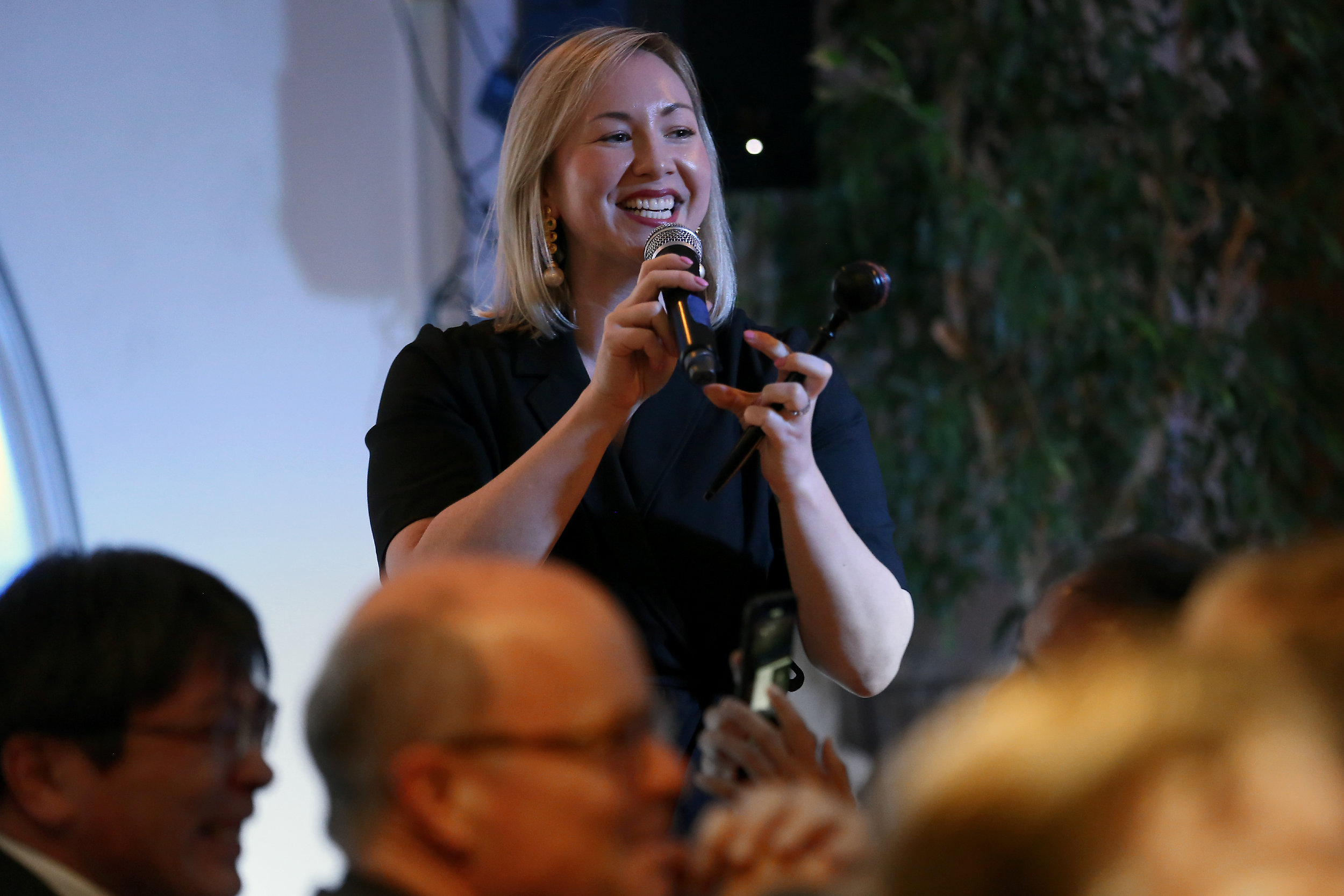









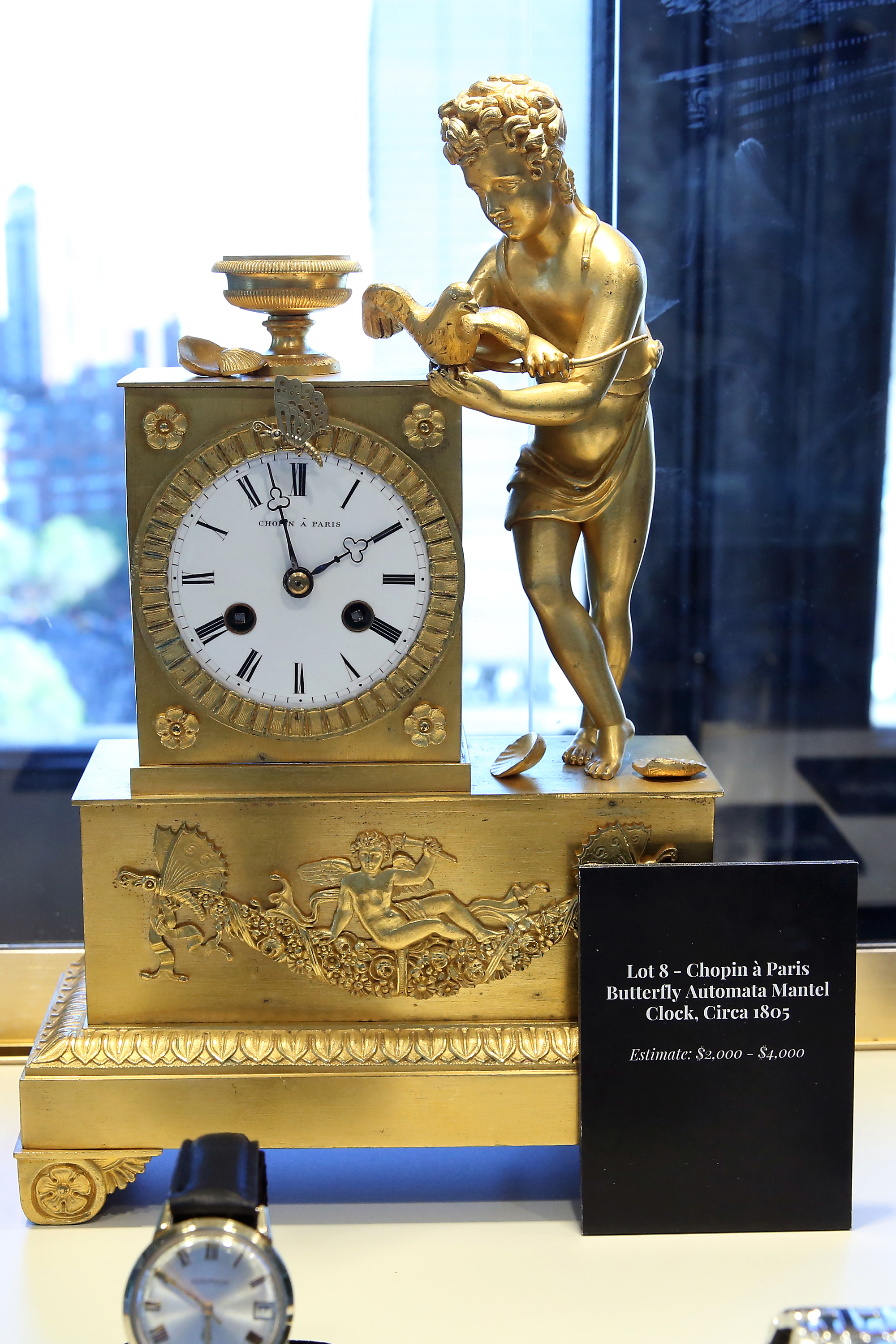














































Photo credit Monica Schipper
Welcoming New HSNY Members, March 2019
DID YOU KNOW? Our March 2019 lecture by Eric Wind had the largest attendance of any HSNY lecture in over 50 years!
HSNY would like to welcome the following new members. It is with your help that we are able to continue flourishing as America's oldest watchmaking guild, and your commitment to HSNY helps us advance the art and science of horology every day.
Aaron Recksiek, UT
Alena Diaz, WA
Cosmin Badea, Canada
Christopher Salt, Canada
David Cowin, CT
David Fox, NY
Eric Wind, FL
Ernie Hu, NY
Fred Savage, CA
Gerard Geier, NJ
Hartford Hage, NJ
H Peter Doble, II, ID
Jason Iceman, CT
Maurizio Tonon, Italy
Michael Cook, NY
Michael Culyba, NY
Pawel M Hrebenko, CT
Stuart D Shanler, PA
Tariq Malik, Dubai
Click here for membership benefit information and to join HSNY!
HSNY Traveling Education Heading to Silicon Valley & Houston this April
The Horological Society of New York (HSNY), America’s oldest watchmaking guild, founded in 1866, announces today Traveling Education stops in Silicon Valley and Houston this April.
The nonprofit organization dedicated to advancing the art and science of horology is imparting horological education in two of the largest states, first hosted at Stephen Silver, Silicon Valley’s destination for extraordinary timepieces and jewelry on April 6-7.
Texans can expect an unforgettable experience the following weekend when HSNY visits Houston, hosted at luxury jewellery and watches Swiss manufacturer Chopard on April 13-14.
HSNY’s Traveling Education courses are four-hour hands-on experiences taught by expert watchmakers. Students can expect to work closely with instructors, who cover material from Horology 101-103 classes taught weekly in New York City, to include lessons in Movement Mechanics, Gear Training, and Winding & Setting.
Throughout the course, students aim to discover what makes a mechanical watch tick by disassembling and reassembling a complete ETA 6497 movement and applying lessons in modern horology. No previous experience is required to take the course.
For tickets, please visit HSNY’s Eventbrite page for a breakdown of dates and times. Ticket sales are reinvested directly back into HSNY’s ongoing educational mission.
Meeting Recap: Collecting Vintage Watches: How to Avoid Common Mistakes, Issues for Collectors to Discuss, and the Future of the Market
Eric Wind, Owner of Wind Vintage
Monday, March 4, 2019
Video recordings of lectures are available to members immediately (using your membership password), and the general public with a 2 month delay.
Given the increased interest in vintage watches, it was no surprise to see the incredible turnout for Eric Wind’s lecture titled Collecting Vintage Watches at the March 4, 2019 lecture series at the Horological Society of New York.
Wind started the lecture by asking two questions: Why watches? What makes a vintage watch valuable?
As far as Wind was concerned, culture, possession, treating things well, and appreciation of history and heritage are justifiable reasons for ‘why watches’. For the next question, the following determinants were listed on what makes a vintage watch valuable: Quality, Complications, Condition, Scarcity/Rarity, Style, Provenance, Association, Freshness to Market, Competition and Other X-Factors.
It didn’t take the audience long to realize that they were going to be bestowed with vintage watch wisdom from Wind’s next slide that was titled ‘What Are The Biggest Mistakes I See Vintage Watch Collectors Making?’ Wind listed 14 mistakes in total:
Birth Year watches
Doing it for ‘Likes’
Not knowing where you are on the passion/value scale
Not having an exit strategy for watches
Not thinking independently: More to life than Rolex, Patek and the Icons
Not having the right tools: UV Light, Geiger Counter and Loupe
Focus only on “Full Sets” (watches with box and papers)
Try to make your watches water resistant if possible
Buying rarity over condition
The best watches typically don’t make it to Instagram
Not recording serial numbers and photos of personal collection
Believing everything you see in a watch auction catalog is original
Not realizing the right strap or bracelet can make all the difference
Not understanding watch auctions
As a former Vice President, Senior Specialist of Watches at Christie’s (HSNY’s new sponsor), Wind touched upon the auction world in regards to vintage watches. One example was a scenario with a mint Rolex Daytona Ref. 6263 with box and papers along with an explanation of the consignment process. Also, it was important to note that the auction house represents the seller – not the buyer. Wind settled the subject by stating, “Just because a watch sold high at auction does not mean that the sale was concluded or that all of that model are worth more.”
After all that wisdom, the audience received another dose of knowledge when Wind produced a watch checklist that included: Provence, Dial, “Lume” on Both, Case and Case Back, Serial Number(s), Manufacture Information, Movement, Other (such as pushers, crown, crystal, etc.), Comparables (by Serial and Price) and Trend.
Considering all the variables with the watch checklist, Wind urges watch collectors to think, “Does it make sense?” as well as “What makes a watch honest?” and “What forms of restoration is acceptable?”. There also was a thought experiment to ponder - “What is the difference in price if a watch’s worth is totally original versus totally restored, but period correct and exactly the same?”.
The lecture was concluded with ideas on the use of blockchain, serial number registries, third-party grading from institutions such as GIA and PSA and Wind’s SWOT (Strength, Weaknesses, Opportunities, Threats) Analysis for vintage watch collecting.
Once again, the turnout for Wind’s lecture was incredible – it was HSNY’s largest turnout in at least 50 years.
HSNY thanks Eric Wind for his fascinating lecture!

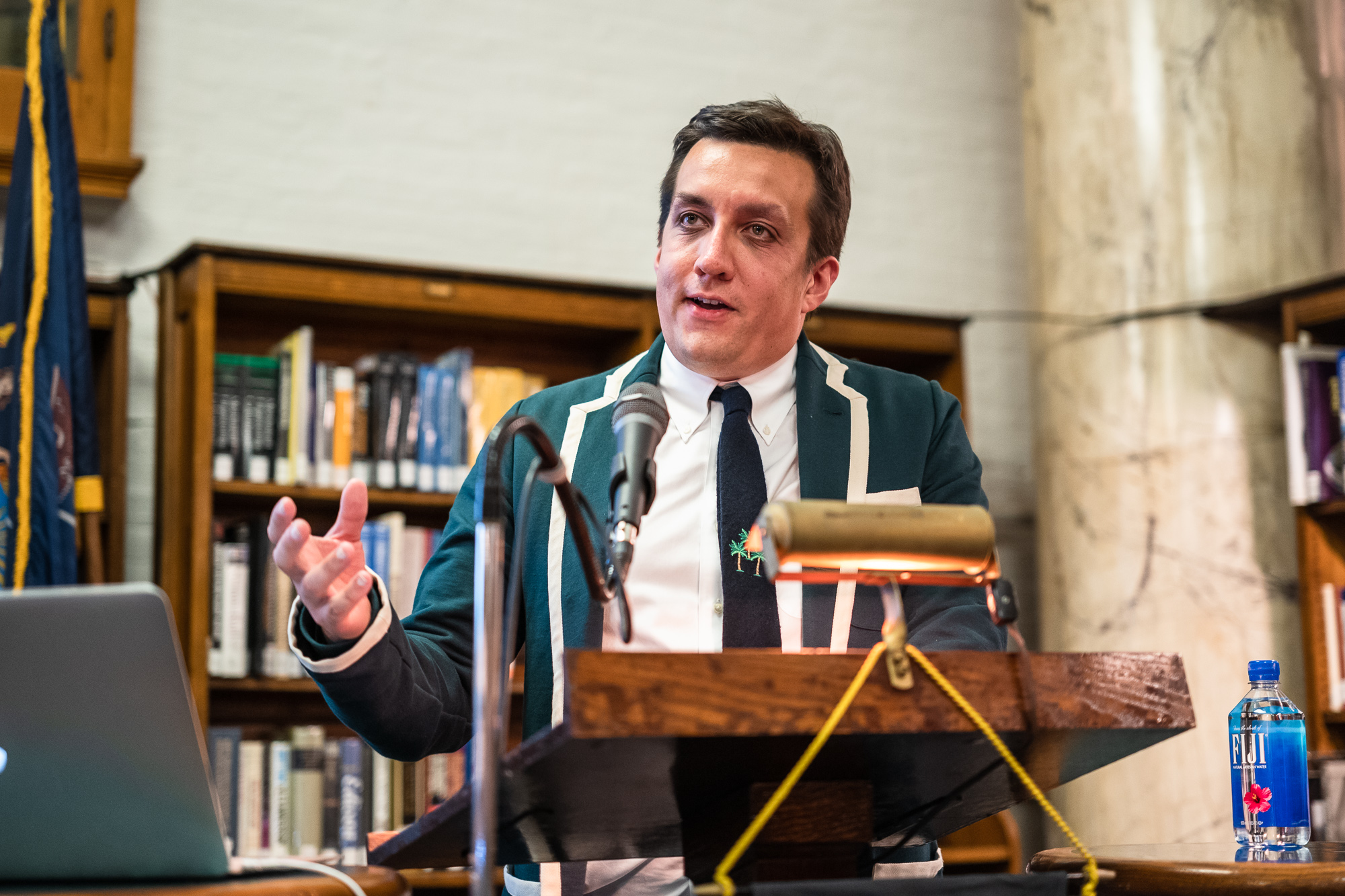

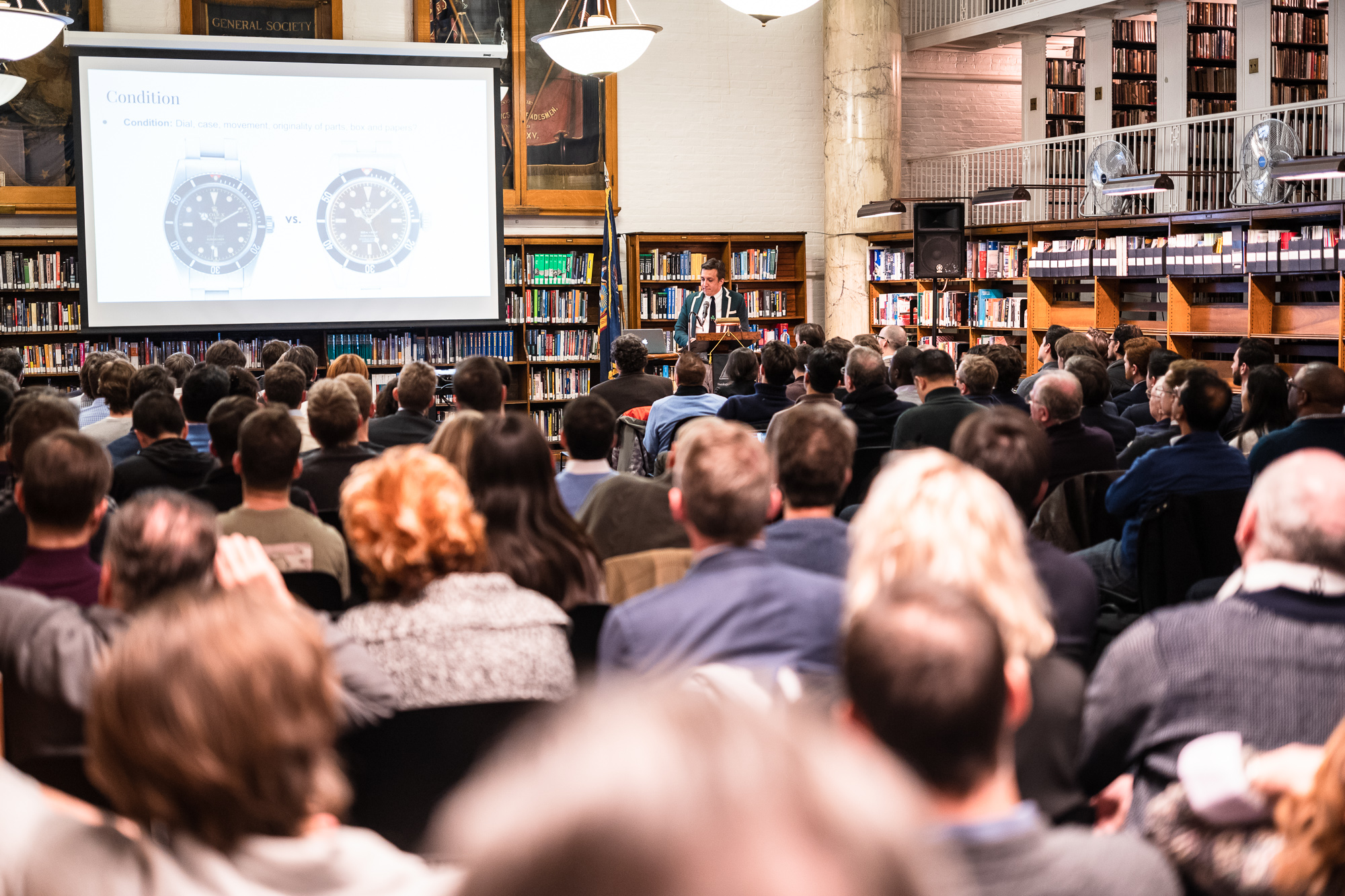
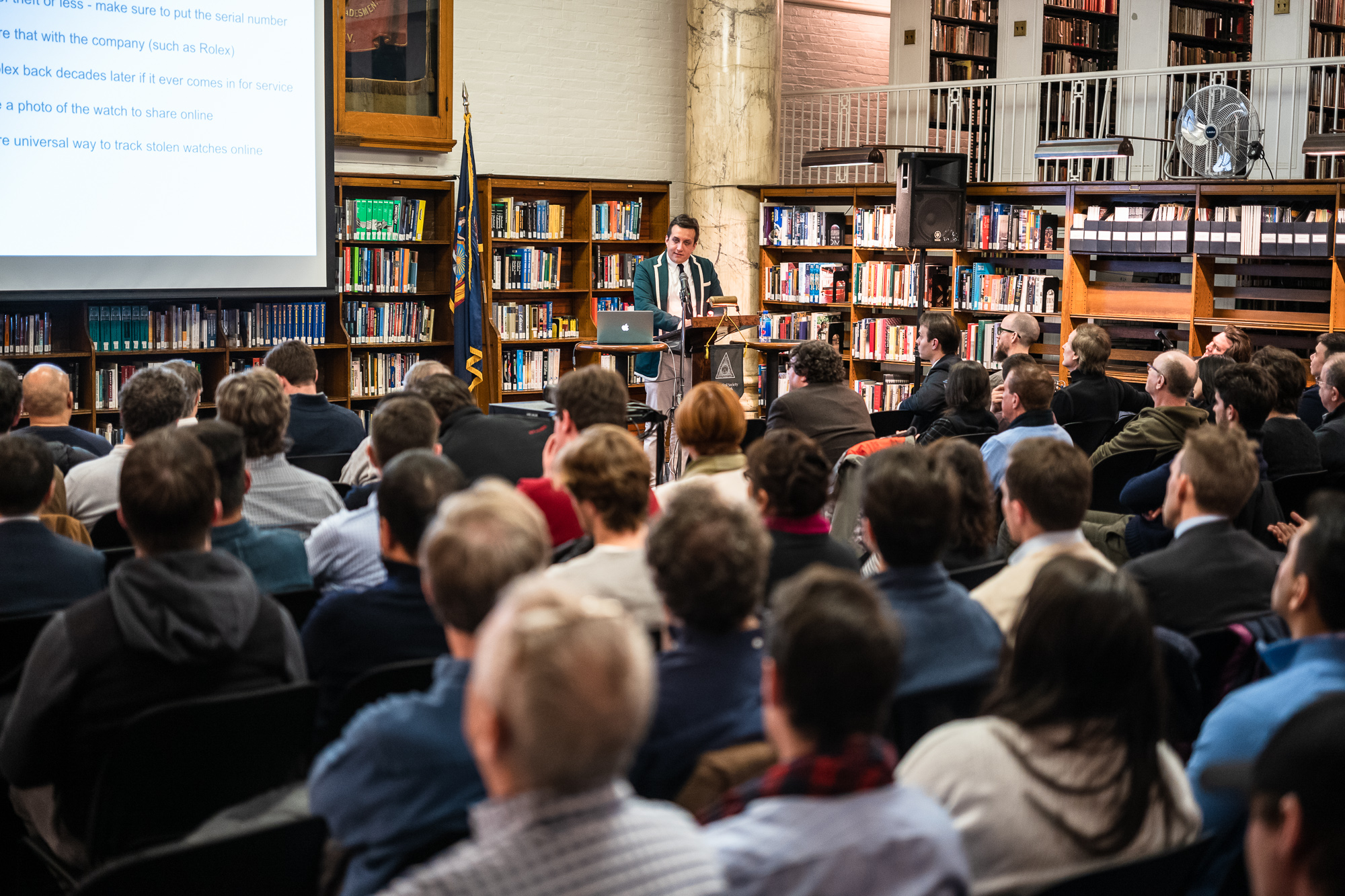
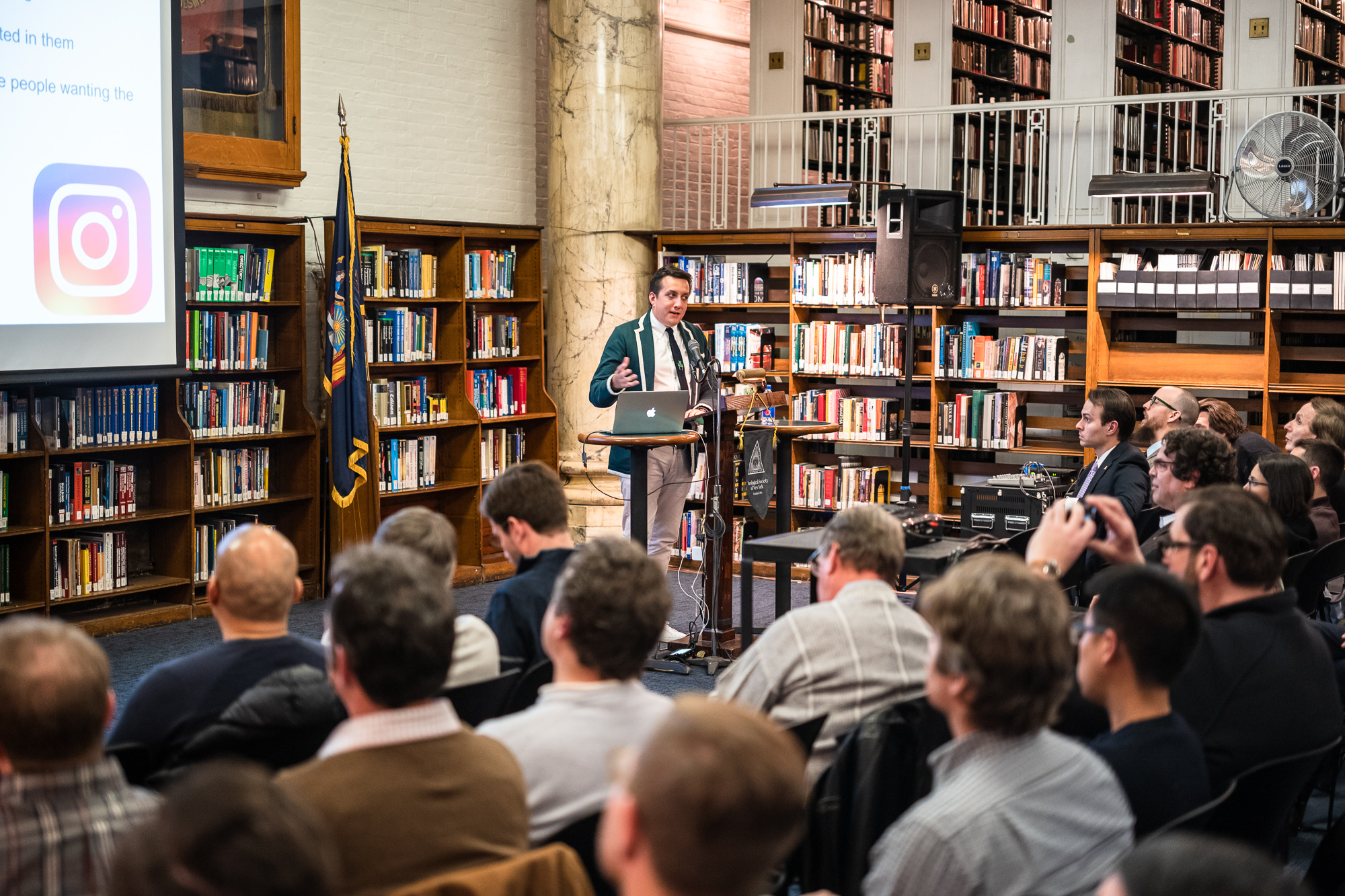

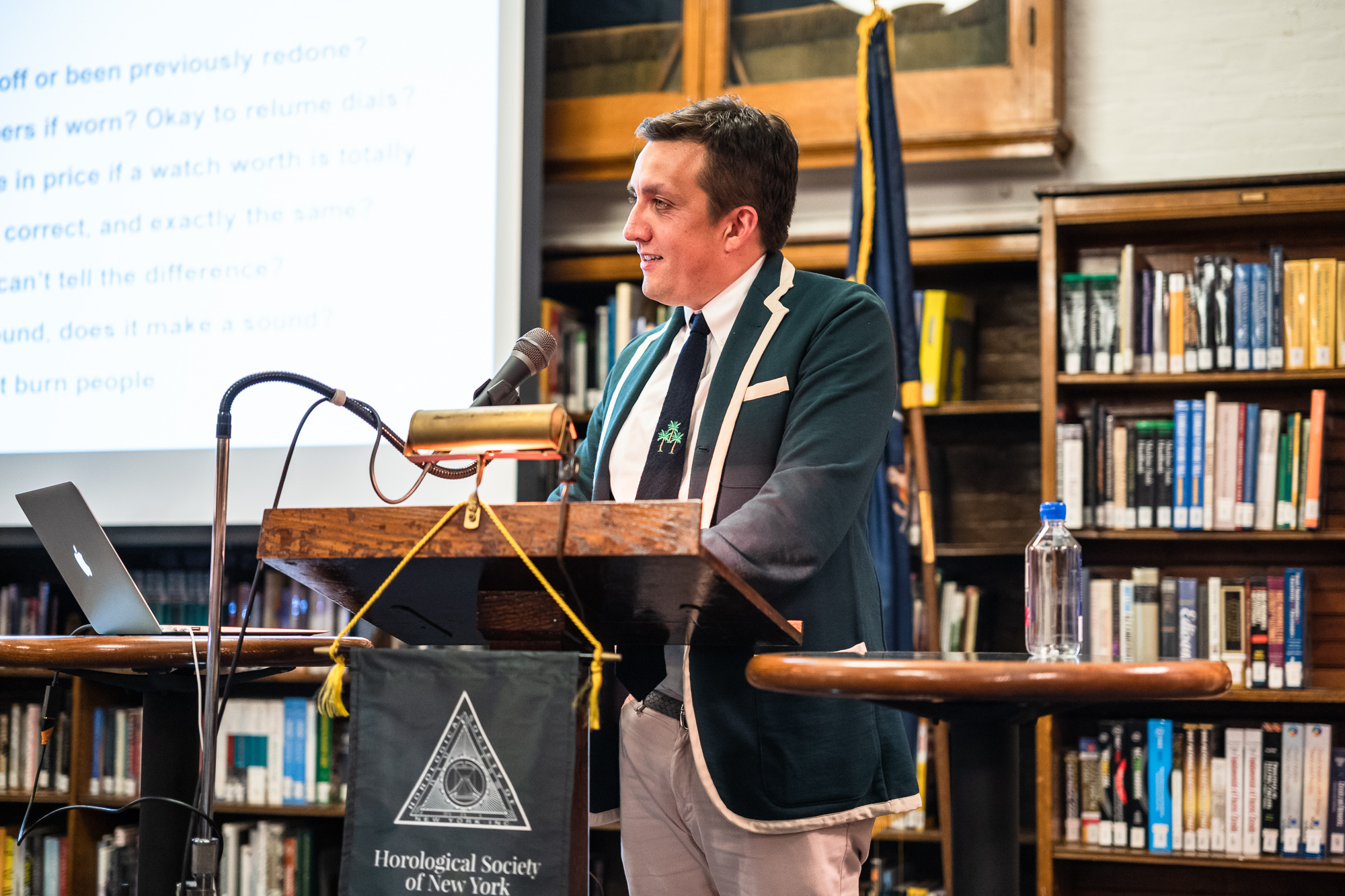

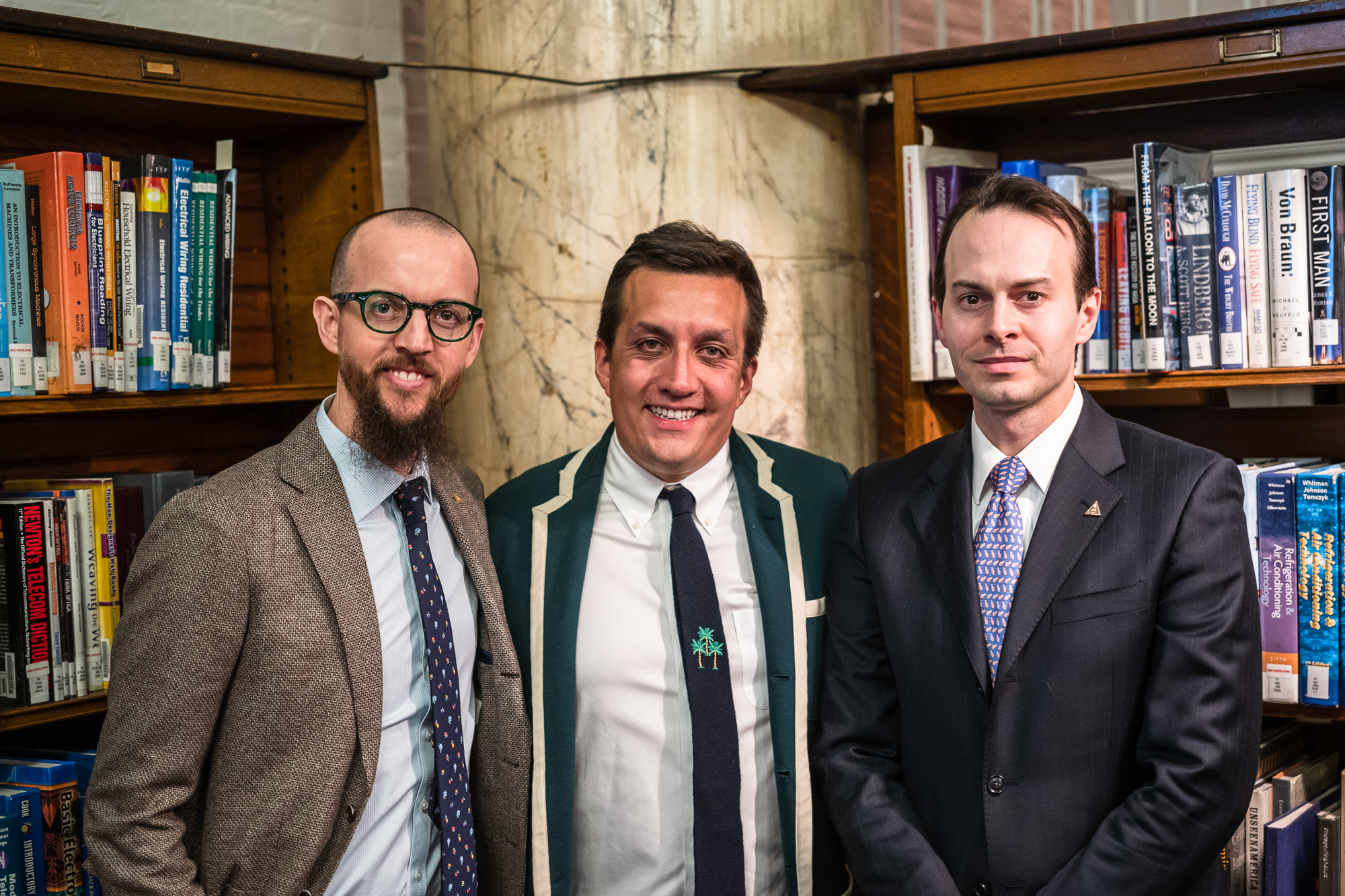
Photography by Atom Moore
Submitted by Melody Benloss, HSNY Librarian & Recording Secretary


























